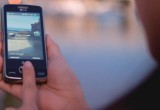Biometric tech goes mainstream via national TV ads
18 May, 2015
category: Biometrics, Digital ID
Two years ago, few would believe that television commercials would be touting biometric technology. But guess what?
Today, ads promoting payments with your fingerprint and iPhone run on primetime TV. Pop star Gwen Stefani encourages consumers to use their MasterCard with Apple Pay to make purchases and win concert tickets, shopping sprees and other perks. Ads have run during the World Series, plugging it as a payment option at baseball stadiums, and during the NBA All-Star Game.
Apple and MasterCard might be the big marketer in this arena but others are stepping up. Intel has a commercial marketing its True Key facial recognition biometric technology with actor Jim Parsons of Big Bang Theory fame. True Key enables consumers to login to their computer or mobile device with a facial recognition app.
While Apple wasn’t the first to put a fingerprint scanner on a mobile phone, it can be credited with bringing the technology to the masses. The addition of near field communication coupled with the fingerprint scanner to make payments extended the use of the biometric to more than simple unlocking of the device.
Apple has also opened up the Touch ID API so that app developers can take advantage of the security technology for access or additional authentication events. Financial institutions and others are taking advantage of the fingerprint scanner on handsets as well as using voice or facial recognition so users don’t have to enter long complex passwords on mobile devices.
Apple Pay is another example of how the company takes something that’s been around for a while and makes it simpler. From enrolling cards to using the system, it’s just easy.
Enrolling the cards was simple. I included the credit card associated with my iTunes account and then decided to add my debit card as well. For that, I took a picture of the card and it was quickly added to my passbook. I also had to go through the process of confirming my iTunes card as well. After both were enrolled, I received emails from my banks confirming the enrollment in Apple Pay.
Now it was time to make some purchases, and first on my list was Walgreens. After the clerk rung up my purchases I placed my phone near the point of sale and the screen just lit up. It showed both of the cards I had enrolled, and by simply touching one or the other, I could choose the card to use.
For the first purchase I choose my debit card, touched my fingerprint biometric on the Touch ID scanner and received the short vibration prompt confirming the purchase was complete. But in this case that wasn’t entirely true. Since I used a debit card, the point of sale asked for my debit card’s PIN and then took me through the rest of the prompts – cash back and confirm amount – before finalizing my transaction.
The next couple of purchases I made I used my other credit card and it worked perfectly. I simply held my phone to the terminal, touched the fingerprint scanner and it worked. I was even able to pay for a cab that had an onboard contactless terminal.
I had previously tested an add-on phone case that enabled me to make payments using my iPhone 4. It was extremely clunky to activate the phone and launch the app to make a payment. The fact that when you hold the phone up to the terminal it just works, and enables you to choose which card to charge the purchase to, makes Apple Pay very easy to use. And then there’s the added bonus of these transactions being more secure. They’re authorized with a biometric, while on the backend all the Apple Pay transactions are tokenized and account numbers aren’t ever shared or transmitted.
It will be interesting to see how Apple’s NFC technology evolves. They’re making money off of each payment and it will be interesting to see how they open up the NFC capability to hopefully enable physical access control and other applications to take advantage of the new iPhone’s NFC chip. Apple will also be including NFC in the Apple Watch coming out later this year.
With a half dozen handsets now including fingerprints for access, and app developers using facial or voice biometrics, it’s an exciting time for the mobile security market.




